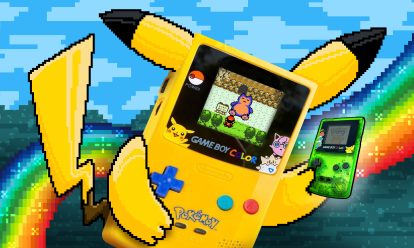
Pokémon for Game Boy Color: Games, Consoles and More!
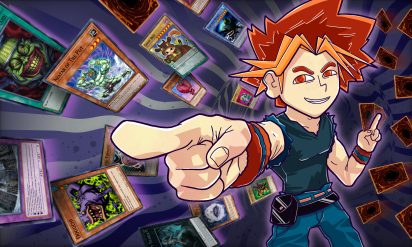
March 3, 2025
30 Funny, Terrifying and Weird Yu-Gi-Oh! Cards
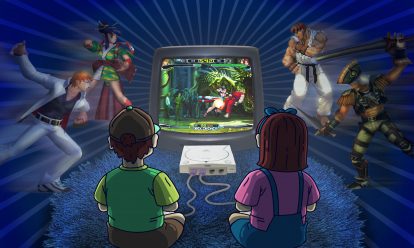
March 3, 2025
10 Awesome Dreamcast Fighting Games You Forgot About
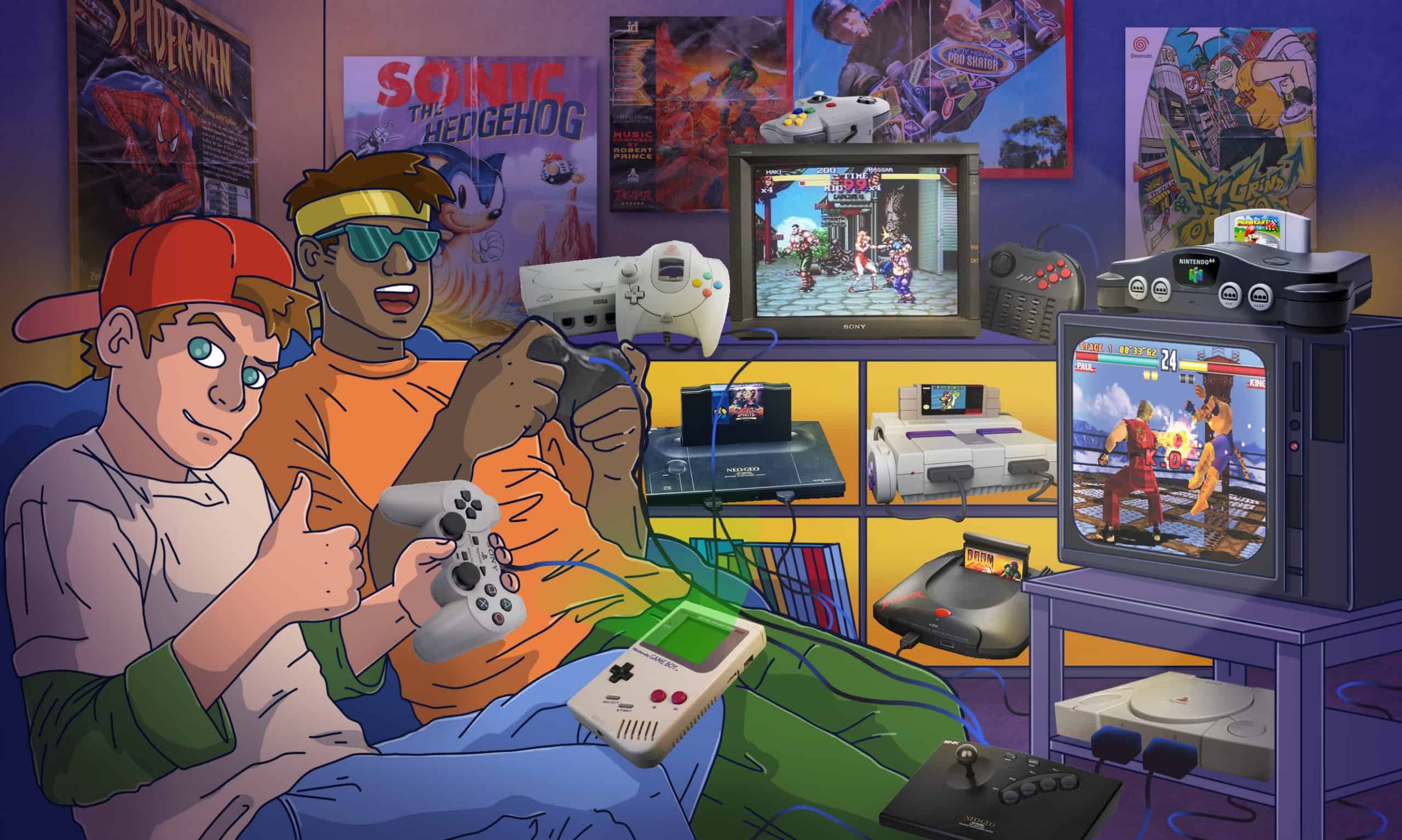
Game consoles of the 90s spawned some of the greatest gaming releases of all time. Let’s revisit the consoles and the influential impact those machines had throughout the decade.
The 90s were a time of significant innovation that helped further transition gaming into a mainstream pastime. The video game consoles of the time introduced immersive 3D characters and environments, and higher production values along with more mature themes which opened up gaming to an older audience.
You’ve probably heard of most of the old-school game consoles below, played with a few, and probably have even forgotten about at least one. However, even though they’ve aged, these 90s game consoles are just as entertaining as the day they hit the market.
So, switch on your CRT TVs and keep your manual handy as we look back at eight of the most famous (and infamous) gaming consoles of the 90s.
Kicking off our list is the iconic Sega Game Gear.
Small handheld game systems just kept popping up in the market during the early 90s thanks to the success of Nintendo’s Game Boy, and Sega wanted some of that sweet, sweet market share as well. The consumer allure of taking your video gaming on the go with you was almost intoxicating. but it didn’t save the Game Gear.
The Sega Game Gear was marketed heavily when it first launched, and the campaign touted its full-color screen technology – which was a big deal at the time considering Nintendo’s Game Boy was still in black & white with its monochrome screen. In the end, the Sega Game Gear sold much fewer units than its rival, and many speculate the reason was actually Sega’s own doing (and undoing).
The company shifted its focus from handheld game systems to developing a home video game console – the Sega Genesis. The strategy ultimately proved to be lucrative… just not for Sega.
The Game Boy was the handheld that became the highest-selling handheld console of the time, handily outpacing the Sega Game Gear by orders of magnitude. Sega did manage to sell 10.62 million units by 1996 – certainly not a number worth scoffing at – but the lack of ongoing support, high price tag, and short battery life contributed to the demise of Game Gear. The last batch went out in 1997.
The handheld console had 364 games available! 90s kids played handheld versions of video game classics like Mortal Kombat, Sonic the Hedgehog, and Master of Darkness.
Because the Game Gear shared a lot of its hardware with the Sega Master System, it was also possible to play Master System titles like Fantasy Zone and After Burner using a special adapter called the ‘Master Gear Converter’ (sold separately, of course).
While the Game Gear didn’t live up to expectations, it was still remembered well enough to get adapted into a retro console. The Game Gear Micro was released in October 2020 and is truly tiny, being only around the size of a matchbox car.
Ironically, most of the Game Gear Micro’s limited size is taken up by two AAA batteries, giving it a longer battery life than the original 90s console. Which, for those who don’t know, was lucky to get 4 hours out of six double AAs. Oh, how far we’ve come.
The Super Nintendo Entertainment System (commonly shortened to the Super Nintendo or SNES) was first released in Japan in 1990 and made its way to North America in 1991. The Super Nintendo followed the NES (Nintendo Entertainment System) and kicked things up a notch by supporting the new 16-bit graphics that were invading the video game industry compared to the NES’ 8-bit graphics. The SNES also had impressive, advanced sound capabilities that blew other systems out of the water at the time.
The Super Nintendo stands as one of the most successful gaming systems of the 90s, having sold 49.1 million units by the time it was discontinued in 2003. Even when more advanced 32-bit consoles began to show up in the gaming industry, the Super Nintendo continued to sell well thanks to its impressive games library – which is still coveted by collectors today.
The Super Nintendo created or continued some of Nintendo’s most iconic and profitable franchises and characters. Games like Super Mario World, Super Metroid, Donkey Kong Country, Super Castlevania IV, Super Mario Kart, and Star Fox were all top sellers that retro gamers still love to play today.
There were also several console bundles that included a popular title as a pack-in game, including the likes of Super Mario Kart, Street Fighter II, The Legend of Zelda: A Link to the Past, and others.
One of the reasons the Super Nintendo Entertainment System had such a long lifespan was that rather than contain a powerful internal CPU that would eventually become outdated, it was designed to take advantage of processing chips included on the game cartridges themselves. For example, the Super FX chip baked into games like Star Fox allowed for simple 3D graphics and light shading, which was ordinarily impossible for the console to generate. This kept the cost of producing the SNES low, and gave game developers a way to produce experiences beyond the bounds of the SNES’s built-in hardware.
The Neo Geo AES (Advanced Entertainment System) is one of the lesser-known 90s game systems, but the cartridge-based arcade console did send shockwaves through the gaming community – primarily due to its staggering price tag.
Neo Geo home console’s launch price in the US was an eye-watering $649.99, which is equivalent to $1430 in 2022. This was a video game system clearly NOT targeted at the common gamer.
Hailing from Japan, the Neo Geo AES was released in 1990 by the company SNK. The video game console itself resembled a miniature version of a traditional arcade game with a joystick and large arcade-style controllers.
At its release, the Neo Geo was the most powerful system on the video game console market, with a custom video chipset that could draw sprites in vertical strips. This meant the Neo Geo could generate backgrounds that were not static images like other game systems of the time, giving all Neo Geo games a vivid and distinctive look compared to titles on other systems.
However, for the average consumer looking for a home console, the Neo Geo’s powerful hardware wasn’t enough to justify its high cost. After only selling one million units of the console, SNK gave up on manufacturing home consoles altogether by the end of 1997.
The Neo Geo may have been short-lived, but the console did give us classic gaming industry staples, such as Metal Slug, a side-scrolling shoot-’em-up game franchise that became immensely popular in arcades and still has a cult following today. Other notable releases for the Neo Geo include famous SNK fighting games like Garou: Mark of the Wolves and Art of Fighting.
Unlike other 90s video game consoles, the Neo Geo was designed first as an arcade system that also had a home console version. The idea was to have a single arcade system that could be loaded with different ROMs rather than having a dedicated custom cabinet for each game.
While this arcade-first design gave the Neo Geo its superior graphics, it also made it too expensive for the average consumer and limited the library to mostly side-scrolling shoot ’em ups and fighting games. In contrast, competing systems like the SNES had a more extensive and varied library with adventure and roleplaying games that could be enjoyed at a more relaxed pace.
A more consumer-focused version with a cheaper price was released in 1994 as the Neo Geo CD. This CD-based system offered the ability to audio CDs as well as disk-based games, all for an entry price of $399 – $250 less than its predecessor.
The Neo Geo CD was also met with limited success and was discontinued just three years later in 1997 after selling 570,000 units worldwide.
The Atari Jaguar was released in North America at the end of 1993 as part of the fifth generation of video game consoles. While Atari was a pioneer in arcade games, the Jaguar proved to be the company’s undoing, and would be their final console for many years.
Unfortunately, the Atari Jaguar didn’t have a particularly broad games catalog, and also cost $249 – making it prohibitively expensive for the time. Nevertheless, Atari justified the price by touting the console as an advanced system based around two 32-bit silicon chipsets (named Tom and Jerry) and a Motorola 68000 processor.
By 1995, Atari dropped the price of the Atari Jaguar to $149.99 but still didn’t manage to sell the remaining stock – even with its over-the-top infomercials.
Yikes.
By 1995, two years after the console debuted, Atari pulled the plug on the Jaguar.
Double yikes.
While only approximately 125,000 units of the Atari Jaguar were sold, this retro game console did end up contributing something to gaming history. For instance, this gaming machine had a trio of excellent first-person shooters, including Tempest 2000, Doom, and Alien vs. Predator.
How anyone managed to play those games with the topsy-turvy control pad is unclear, but it definitely happened.
Attempting to make a comeback in the home console market, Atari has recently released a new micro-console called the Atari VCS (codenamed Ataribox). The Atari VCS runs a Linux-based operating system and can be used as a PC as well as a gaming console capable of playing retro Atari games and other newer titles.
Unfortunately, the Atari VCS has received mixed reviews. While most critics praise the visual design of the console, they take points away due to its limited hardware capabilities and the poor utility of its Classic Controller.
Next is the iconic Sony PlayStation, the world’s first CD-based console (sorry, Philips CD-i, Sega CD, and other CD-based add-ons). With its sleek, shiny disks, complex 3D games, and button layout that would lay the foundations for all future PlayStation controllers – the console expanded the limits of what video games were capable of prior.
In 1993, Sony tried (and failed) to take a bite out of the console industry through collaborations with Sega and Nintendo. Fresh from defeat, Sony looked to its resident genius, Ken Kutaragi. Ken would be the driving force behind Sony’s first machine, and as they say, the rest is history. Gamers quickly took to the machine’s futuristic feel, and the console felt far more advanced than what some started to see as – clunky, dust-filled cartridges.
The console ruled the early 90s with games like Metal Gear Solid, Tekken, Gran Turismo, Tony Hawk’s Pro Skater, Final Fantasy (deep breath), Tomb Raider, Resident Evil, Spyro the Dragon, Sly Cooper, and Crash Bandicoot.
They knew that if they were going to carve out a space for themselves in the video game industry, the Sony PlayStation would need to come out swinging. As you can probably tell from the above lineup of solid bangers and the division’s continued success, they definitely achieved that goal.
While pirating video games had existed since the 1980s, the original PlayStation was the first console where modchips were used. Sony knew that CD games would be more susceptible to piracy, so they built a copy protection system into the console that would authenticate discs when the console booted. It wasn’t long before crafty individuals began to open up their consoles and solder modchips onto the circuit board, allowing them to play pirated games freely.
With just a little bit of silicon and a hot iron, you could play games of all kinds! Even if you didn’t own them.
Not that we would condone that behavior, of course.
Arguably one of everyone’s favorite old-school consoles – the N64 – first hit store shelves in Japan in June 1996 before making its way to North America that September. Unfortunately, Europeans and Australians had to wait until 1997 to get their hands on one.
What a difficult wait that must have been!
The 3D graphics of the N64 were far superior to anything else on the market at the time, and many gamers today even credit the 64-bit system with getting them into gaming. To date, the Nintendo 64 has sold 32.93 million units. Interestingly, many consider the console a failure because it was in direct competition with the PS1, which sold over 100 million.

Still, the N64 steadily sold on the market for seven years. The last game ever released on the system was the iconic skateboarding game Tony Hawk’s Pro Skater in 2002. By 2004, the last units were shipped.
The N64 would be the last major home console to use cartridges as its primary storage format… until the Nintendo Switch came along, that is. If you have any old N64 games that have been gathering dust, check out our ultimate guide to cleaning N64 cartridges.
The N64 as a platform launched or reinvented many iconic franchises that are still loved to this day. Super Smash Brothers, Mario Kart, GoldenEye 007, Turok, and The Legend of Zelda: Ocarina of Time are among fan favorites. Banjo-Kazooie and Wave Race 64 were also two of the more sought-after cartridges.
In 1999 Nintendo released the 64DD (64 Disc Drive), which was a peripheral platform that connected to the bottom of the console. Released only in Japan, the 64DD made it possible to play disk-based N64 games and even browse the internet via the now-defunct Randnet service.
Unfortunately, 64DD was discontinued after a limited mail-order release, with plans to launch it in America and Europe scrapped. Only a handful of titles were released for the platform, with many planned releases being repurposed for Nintendo’s next console, the Gamecube.
While the 64DD failed commercially, it was a technological leap for Nintendo and laid the groundwork for features in their future games and products. For example, the rewritable memory storage capabilities of the 64DD are what inspired the creation of the popular Animal Crossing series with its persistent world.
For the most part, the Sega Dreamcast was ahead of its time. Sega’s final console was a visionary piece of hardware, and many argue that the built-in modem, hugely innovative controllers, and ability to truly embrace online gaming might have been too much for 1998.
Yeah, that’s what happened! It was just too far ahead of its time!
The console preceded Sony’s PlayStation 2, Nintendo’s GameCube, and Microsoft’s Xbox, and perhaps even helped inspire them? Between the time it launched and the time it was discontinued in 2001, the Sega Dreamcast sold 10.6 million units.
We still miss it dearly.
The Sega Dreamcast is well-known for classic Sega hits like Jet Set Radio, Sonic Adventure, Shenmue, Soulcalibur, Seaman, Rez, The House of the Dead 2, Dead or Alive 2, and NFL Blitz 2000. While you’re here, check out our list of the best Dreamcast fighting games.
Something many don’t know about the Sega Dreamcast is that Sega collaborated with Microsoft during the console’s development. Microsoft provided Sega with a custom Windows operating system and development kits to create games.
There’s little doubt that Microsoft’s engineers learned a lot from this partnership which informed the development of the original Xbox a few years later. In fact, when you compare the overall shape and button layout of the Dreamcast and Xbox controllers, they look remarkably similar.
Very sneaky, Microsoft…
Nintendo’s Game Boy Color (GBC) is one of the landmark consoles of the 90s and one of the greatest evolutions in video game history. Years after the first Game Boy, Nintendo pulled out all the stops with a smaller version of the system that displayed color.
After Sega discontinued the Game Gear in 1997, the GBC’s only competition was the original Game Boy. Even Neo Geo tried to get in on the action with their Neo Geo Pocket Color in 1991, but the sales were incomparable.
The Game Boy and the Game Boy Color were massive hits, which combined have sold over 118.69 million units to date. The pair stand as the 3rd best-selling video game consoles of all time, beaten only by Nintendo’s own DS and the Sony PlayStation 2.
The GBC was discontinued in 2003, shortly after the release of the Game Boy Advance SP.
Without a doubt, the Game Boy Color’s best-selling game is Pokémon Gold and Silver, which sold 23 million units worldwide. Other top sellers included Wario Land: Super Mario Land 3, Dr. Mario, and Tetris. Want more? See what made the list for our favorite Game Boy Color games in every genre!
Appropriately, the exterior casing of the Game Boy Color came in several different color variations you could purchase. It was also one of the first handheld consoles to have limited edition versions with decals from brands like Lunchables and Doraemon, as well as the Pokémon and Legend of Zelda games.

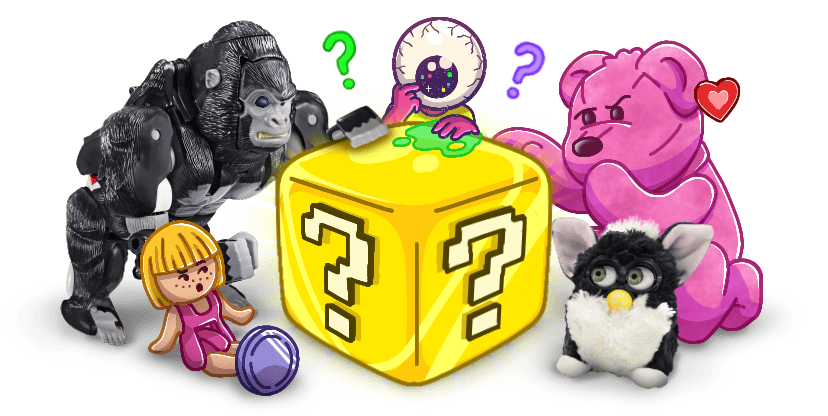
The Sony Playstation was the best-selling console at the turn of the century, with the Game Boy and Game Boy Color following close behind. By the end of its impressive 12-year run, the Playstation had sold a whopping 102 million units.
Today’s TVs have slowly phased out old RCA and component ports in favor of a simple HDMI port (used by modern gaming systems). With this being the case, your current TV may not have the correct visual ports to connect with an older console. There are several ways to get around this, such as connecting through a DVD player or investing in an adaptor cable.
Of course, another way around this issue is to use an older TV with the correct ports. In fact, many retro gamers will seek out old CRT television sets for a more authentic gaming experience.
While the consoles that dominated the 1990s are no longer being manufactured, it’s still possible to find them on the second-hand market (although some are rarer than others). Luckily, video game companies have started to release retro consoles that emulate systems from decades past (with a library of popular games pre-installed). Some notable examples include the SNES Classic (2017) and Playstation Classic (2018).

Mike is a video game enthusiast, a chronicler of the 90s, and a collector of many things. Born in the mid-90s, he was able to catch the wave of some of the best things the decade had to offer, like Power Rangers, Pokémon, Bagel Bites, the list goes on. Despite the amount of time that has passed, he still enjoys many of those things today! If he’s not writing or gaming, he’s probably wondering why Warriors of Virtue didn’t take off the same way Teenage Mutant Ninja Turtles did.

Check it out!

Pokémon for Game Boy Color: Games, Consoles and More!

March 3, 2025
30 Funny, Terrifying and Weird Yu-Gi-Oh! Cards

March 3, 2025
10 Awesome Dreamcast Fighting Games You Forgot About